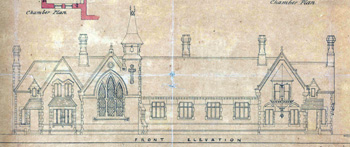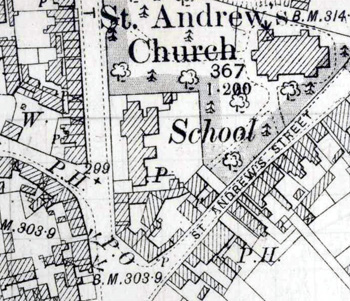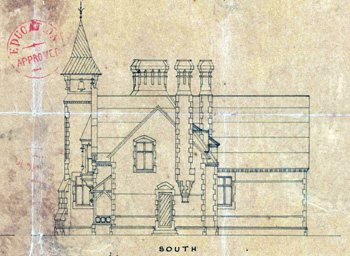Saint Andrews School Leighton Buzzard

Saint Andrew's School front elevation of about 1870 [AD3865/1]
The boys' and girls' schools at Saint Andrew's opened in 1872. Later 19th century notes in the Parish register for 1732 to 1774 [P91/1/2] note that the boys' school opened on 22nd January and the girls' school on 2nd February. On 14th February Miss C.Willis endowed the schools with £500. The schools were termed Church of England Schools and stood on the east side of Church Street opposite the junction with Mill Road. In April 1893 it was decided, with the managers of Pulford's Schools, to convert Pulford's into a boys' school and Saint Andrew's into a girls' school, boys from Saint Andrew's moving to Pulford's and girls at Pulford's moving to Saint Andrew's on 15th May that year. At the same time both schools became free to pupils, a subscription having been paid by parents hitherto.

Site of Saint Andrews School in 1901
The Education Act of 1902 abolished School Boards, replacing them with a Local Education Authority which, for Bedfordshire, was Bedfordshire County Council. Thus board schools became known as council schools. Remaining National and British Schools as well as other free, charity and church schools became Public Elementary schools, partially controlled by the Local Education Authority, thus Saint Andrew's became a Public Elementary School
Bedfordshire & Luton Archives & Records Service has a scrapbook of cuttings of visits made to most Bedfordshire Schools by School Inspectors for a period from just before the First World War through the inter-war years [E/IN1/1]. The first inspection of the school in the volume came in 1910: "The school is doing well and has some exceptionally good features. Among these I would particularly commend the thorough and systematic revision of the work of past years, the careful and scientific teaching of Needlework and the carefully thought out scheme of instruction in domestic subjects - instruction made, as far as opportunities allow, interesting and practical". The school was visited again two years later (average attendance 179): "The School is in excellent order and continues to do well in all ways. Instruction in Needlework and in other braches of Home-craft is especially worthy of praise. Some of the desks are very old and worn and need renewal, and further cupboard accommodation is very desirable".
The first inspection recorded after the First World War was in 1921, average attendance 190: "The new Headmistress, who came on October 5th 1921 has found a School in which the tone is very pleasant" However the lowest two classes were very weak: "It would appear that they have been taught by the Head Teacher herself, who had of course innumerable other duties to fulfil and had to interview parents and visitors of all sorts; hence the children could not receive the full attention which was necessary with the result that there are a number of weak children in the higher classes of the School. The work which the lowest class did at this visit was very poor indeed. This is all the more distressing because the children appear to be trying to do their best and are apparently not sub-normal children. The new Headmistress has many ideas for the improvement of the School: these can hardly be carried out is she has to devote her attention to this class. Additional assistance, at any rate for a year or two, is eminently desirable".

Saint Andrew's School plan about 1870 [AD3865/1] - to see a larger image pease click on the image above
The next visit dealt with the premises: "I visited this school with the School Medical Officer. The heating throughout the school is bad. The lighting of the two classrooms divided from each other by a partition is bad. We found that four offices would not flush, and the Teacher's was flushing badly. Apparently new cisterns are wanted in several cases. There are 197 girls and only four offices at the present time are working properly. This matter requires immediate attention. The other defects mentioned above should be put right as soon as possible. A partition is wanted in the long room: and the worn places in the playground need attention".
In 1924 the inspector noted: "This school has made very considerable progress since the last Report was written". Five years later, with average attendance down to 149: "In this school, which is conducted in premises that entail difficulties in organisation and with a staff some of whom find it difficult to adapt themselves to fresh ideas and methods, the Head Mistress has obtained an excellent tone, good industry and good results…The most desirable change is in the direction of more reading for content in the classes below the top and, through this, more training for real private study". By 1931 average attendance was up to 180 and the inspector reported: "This girls' school is practically full to the limits of its revised accommodation although no children have been admitted from infants' departments for eighteen months…The school is conducted in an efficient manner and much of the work calls for commendation…The girls' behaviour and manners in the school are very good".
On 1st April 1933 the school became a Junior Girls Council School and the first inspection in the volume after this was in 1937 when average attendance was 175: "There is much to praise in the conduct of this school, which in many respects is extremely successful with the normal and much brighter children. It is felt however that the time has come for some reconsideration of the methods in use…It should be remembered that the school is conducted in premises in which, judged by any standard, to work must be very difficult. It is far too full, judged by modern standards; no class is in a really comfortable or spacious classroom, two classes work in one room, and the cramped conditions are uninspiring. Improvements have been made in the premises, but much remains to be done in heating, lighting, ventilation inside, and to the playground outside to give those who work in it a really fair chance. In these circumstances the hard work of the staff deserves recognition".

Saint Andrew's School south elevation about 1870 [AD3865/2]
This school continued until 1946 when the Education Act 1944 came into force. Under the act County Primary Schools took children up to eleven years of age, after which they sat an examination (the Eleven Plus as it was known), the top 25% then went to Cedars School, the remainder to Beaudesert (boys) or Mary Bassett (girls), later Brooklands or Gilbert Inglefield (mixed) County Secondary Modern Schools. The act also created two types of successor to the public elementary schools - the Voluntary Aided and Voluntary Controlled schools. Voluntary Aided schools are those in which the Local Education Authority funds the school but the governing body is independent, they are usually Anglican or Roman Catholic schools. Voluntary Controlled schools own their own buildings whilst the staff are employed directly by the governors. Saint Andrew's became a Voluntary Aided County Primary Girls' Junior School, infants in the town going to Beaudesert County Primary Infants' School.
The school closed in 1971 and the premises were demolished to make way for housing. The last days were noted poignantly in the school log book [SDLeightonBuzzardSaintAndrews3]: "July 22nd closing ceremony attend [sic] by Mr.Shallard, The Vicar, Father Lack, the Managers, other heads a great number of former staff including Mrs.Payne who is I believe over 80. Mrs.Wombey's needlework on show and plenty of art on the walls. Mrs.Wombey outside with the dancers until after 10 p.m. Presentations made to all the Staff and Dinner Helpers by the Parent Teacher Association. A cheque presented to me from former pupils. A bunch of flowers from old pupils at Gilbert Inglefield presented by a former Head Girl, and another group gave me a pen presented by an old girl's little daughter. I was pleased to see two former head girls quietly making themselves useful. Unfortunately the first person to ring the bell pulled too hard and it got stuck. Refreshments arranged by Miss Evans from Bedford helped by P.T.A. July 23rd school closed. Flag lowered. Mrs.Withey to go to Clipstone Brook new school where Miss Melne having gained her pass degree in French will also be teaching. Mrs.Wombey does not yet know where she is going. Mrs.Rowe caretaker for over 20 years has not yet got a job. Cleaning up to be done next week".

Site of Saint Andrew's School Church Street December 2008
Sources
- P91/0/9 f.69: notes on buildings and first teacher: 1870-1891;
- P91/1/2: notes on school: 1872;
- AD3865/26: plans of school and teachers' houses: c.1872
- P91/0/9 f.134: notes on cost of education: 1872-1882;
- P91/0/9 f.157: notes on teachers: 1872-1896;
- P91/0/9 f.161: notes on staff: 1872-1896;
- P91/0/9 f.126: notes on school with statistics: 1874-1880;
- P91/0/9 f.88: school returns: 1876-1879;
- P91/0/9 f.81: notes on accommodation: c.1880;
- P91/25/2: letters about school: 1893-1903;
- P91/29/3: notes from conveyance and trust deed: c.1900;
- P91/29/1-2: school managers minute books: 1900-1921;
- E/SA3/1/2: managers' and inspector's reports: 1903;
- E/TE5/3: details of teachers: 1904-1908;
- E/TE5/4: details of teachers: 1908-1912;
- E/IN1/1: inspector's reports: 1910-1937;
- SDLeightonBuzzardStAndrews2: school logbook: 1912-1933;
- SDLeightonBuzzardStAndrews3: school logbook: 1933-1971;
- P91/2/57: proposed sale of part of site for road improvements: 1953-1956;
- CA8/712: building maintenance file: 1964-1972;
- P91/2/49: correspondence regarding proposed redevelopment: 1970-1973;
- P91/2/50: correspondence regarding disposal of turret clock from school: 1971-1972